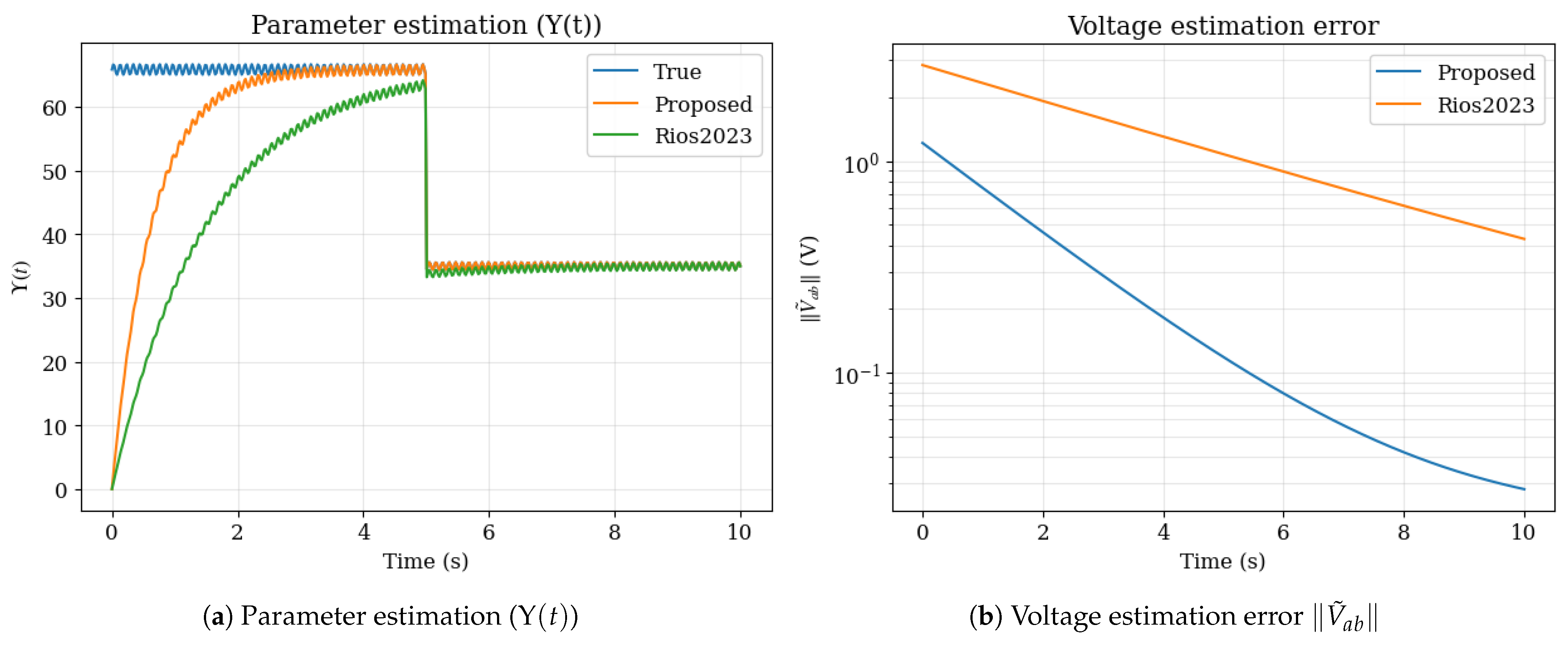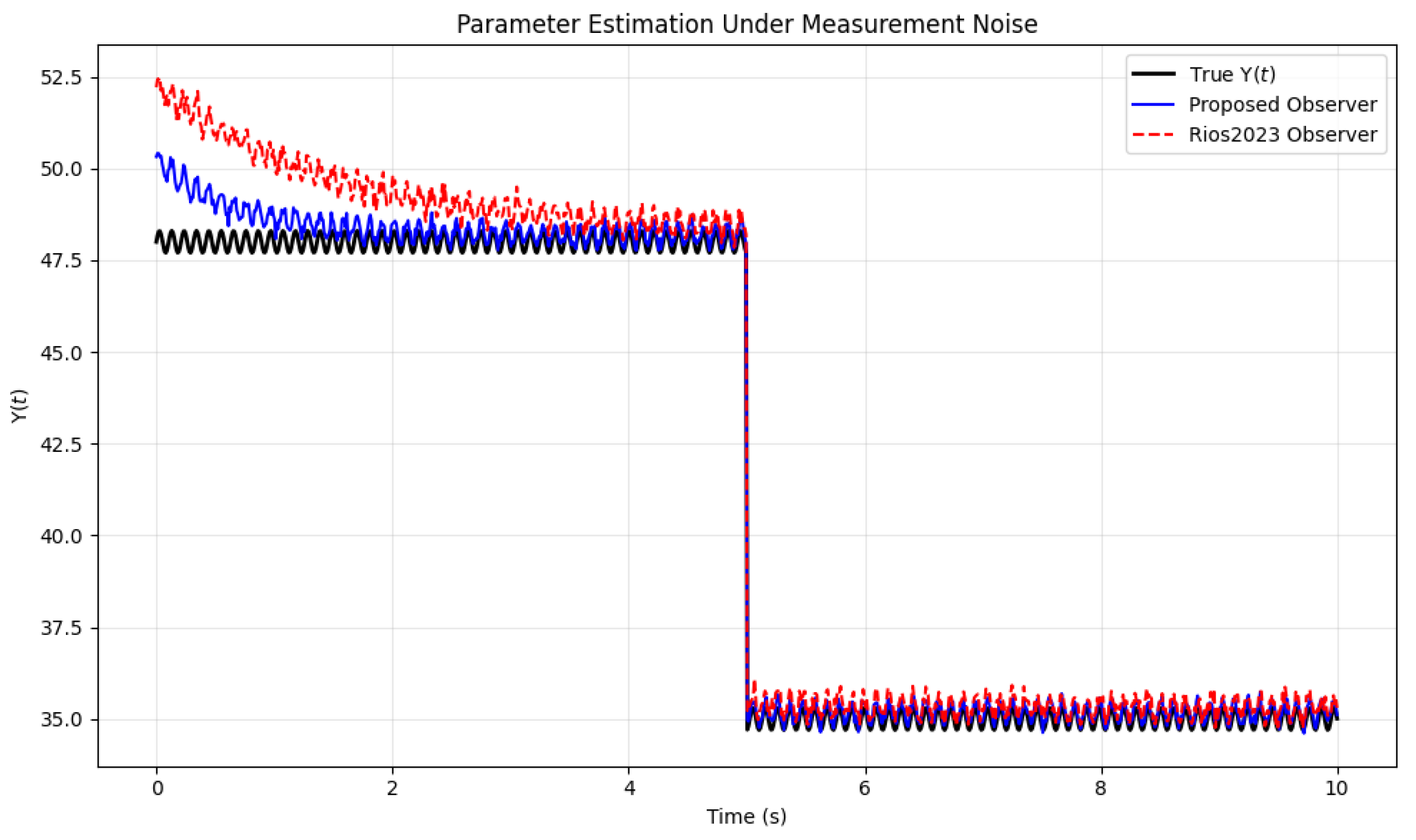Adaptive Observer Design with Fixed-Time Convergence, Online Disturbance Learning, and Low-Conservatism Linear Matrix Inequalities for Time-Varying Perturbed Systems
Abstract
1. Introduction
- Notation
- : n-dimensional Euclidean space.
- : Euclidean norm for vectors; induced spectral norm for matrices.
- : Space of essentially bounded measurable functions.
- : Sign-preserving power function for , .For vectors, .
- : Sequence of integers .
- : Identity matrix of size ; : zero matrix of size .
- , : Minimum and maximum eigenvalues of a matrix.
- , : Class (strictly increasing, if unbounded) functions.
- : Augmented error vector (state/parameter/disturbance errors).
- : Parameter-dependent Lyapunov matrix in (9), where are time-varying parameters (e.g., , ).
- : Slack matrix in LMI constraint (10), introduced to decouple Lyapunov terms and reduce conservatism.
- N: Grid resolution for parameter discretization, chosen empirically based on parameter variability (see Algorithm 1).
- : Fixed-time convergence exponent in observer (4a).
- T: Predefined convergence time bound in Theorem 1.
- : Adaptive gain for disturbance estimation in (5).
- : Residual disturbance approximation error.
- : Uniform lower eigenvalue bound for .
- : Positive definite gain matrix for the nonlinear injection term in (4b).
- : Smoothing parameter for the function in (4c), mitigating chattering.
| Algorithm 1 Grid-based gain synthesis |
|
2. Preliminaries
- 1.
- It is finite-time-stable, i.e., as , where .
- 2.
- The settling time is bounded by a constant , independent of .
3. Problem Statement
- Requirement of static disturbance bounds .
- Asymptotic rather than fixed-time convergence.
- Conservatism from diagonal gain matrices.
- Estimates and without static disturbance bounds.
- Guarantees in fixed time T.
- Synthesizes gains via reduced-conservatism LMIs.
4. Finite-Time Observer Design with Online Disturbance Learning
- 1.
- Gains satisfy parameter-dependent LMIs (Section 5).
- 2.
- , .
- 3.
- .
- Bounded derivatives (A3,A4): ,
- Significant inequalities:
5. Reduced-Conservatism LMI Synthesis
6. Comparative Analysis
6.1. Methodology Comparison
- Versus High-Gain Observers [8]: While high-gain observers provide robustness to uncertainties, they inherently amplify measurement noise and suffer from peaking phenomena. Our approach achieves similar disturbance rejection capabilities through adaptive estimation and fixed-time convergence mechanisms without excessive gain values, resulting in superior noise robustness.
- Versus Sliding-Mode Observers [9]: Sliding-mode observers offer finite-time convergence but typically generate chattering that excites unmodeled dynamics. Our method replaces discontinuous switching with smooth approximation and adaptive disturbance learning, eliminating chattering while maintaining fixed-time convergence guarantees.
- Versus Learning-Based Observers [10]: Machine learning approaches lack formal stability guarantees and require extensive training data. Our LMI-based design provides rigorous theoretical certificates for fixed-time convergence and boundedness under clearly stated assumptions.
6.2. Interpretations of Key Criteria
6.2.1. Convergence
- Fixed-Time (Proposed): Ensures by a predefined T, critical for time-sensitive applications (e.g., fault detection in power systems).
- Asymptotic ([1]): Guarantees as , which may be insufficient for real-time control.
6.2.2. Disturbance Handling
- Proposed: Eliminates need for static bounds via online estimator , adapting to unmodeled dynamics.
- [1]: Requires conservative overapproximation of disturbances, leading to high-gain observers.
6.2.3. Conservatism vs. Complexity
- Proposed: Parameter-dependent LMIs reduce conservatism but require solving LMIs. Suitable for .
- [1]: Diagonal LMIs () are computationally efficient but overdesign gains for worst-case scenarios.
6.2.4. Implementation
- Proposed: Requires offline grid-based LMI solving and real-time interpolation. Not scalable for .
- [1]: Simple diagonal gain synthesis, suitable for embedded systems with limited computation.
6.3. Practical Recommendations
- Choose proposed observer if the following is the case:
- –
- Fixed-time convergence is required (e.g., safety-critical systems).
- –
- Disturbance bounds are unknown or time-varying.
- –
- System dimension is low ().
- Choose [1] if the following is the case:
- –
- Asymptotic convergence suffices.
- –
- Disturbance bounds are known and static.
- –
- System dimension is high ().
7. Simulation Results
7.1. Application to Power Systems
- : Grid voltage with V (nominal).
- : Unknown time-varying parameter ( Hz nominal).
- : Disturbance (parasitic loads).
- : Time-varying frequency.
Observer Implementation
7.2. Implementation and Reproducibility Details
7.2.1. Comparative Results
7.2.2. Interpretation
- Fixed-Time Convergence: Achieved via the term in (12).
- Online Disturbance Learning: Adaptive compensates without prior knowledge of .
- Reduced Conservatism: Lower gains ( vs. ) due to slack matrix in LMIs.
7.3. Robustness to Measurement Noise
8. Conclusions
Author Contributions
Funding
Data Availability Statement
Acknowledgments
Conflicts of Interest
References
- Ríos, H.; de Loza, A.F.; Efimov, D.; Franco, R. An LMI-Based Robust Nonlinear Adaptive Observer for Disturbed Regression Models. IEEE Trans. Autom. Control 2023, 69, 4035–4041. [Google Scholar] [CrossRef]
- Jenhani, S.; Gritli, H. An LMI-based robust state-feedback controller design for the position control of a knee rehabilitation exoskeleton robot: Comparative analysis. Meas. Control 2024, 57, 1326–1346. [Google Scholar] [CrossRef]
- Polyakov, A. Nonlinear feedback design for fixed-time stabilization of linear control systems. IEEE Trans. Autom. Control 2011, 57, 2106–2110. [Google Scholar] [CrossRef]
- Boyd, S.; El Ghaoui, L.; Feron, E.; Balakrishnan, V. Linear Matrix Inequalities in System and Control Theory; Society for Industrial and Applied Mathematics: Philadelphia, PA, USA, 1994. [Google Scholar]
- Harris, M.W.; Sarsılmaz, S.B. LMI-based design for regional fixed-time nonlinear control with settling time and control constraints. Nonlinear Dyn. 2025, 113, 6979–6995. [Google Scholar] [CrossRef]
- González-Cárdenas, Y.; López-Estrada, F.R.; Estrada-Manzo, V.; Valencia-Palomo, G.; Santana-Ching, I. LMI-based discrete LPV controller design for systems with inherent couplings in the scheduling vector: Improved robustness and performance. J. Frankl. Inst. 2025, 362, 107419. [Google Scholar] [CrossRef]
- Motchon, K.M.; Guelton, K.; Etienne, L. LMI-based conditions for mode detectability analysis of discrete-time switched linear systems estimated with minimum distance algorithm. Automatica 2025, 173, 112024. [Google Scholar] [CrossRef]
- Farza, M.; Chehaïbi, O.; Saïd, S.H.; M’Saad, M. Design of a Saturated Filtered High Gain Observer for a Class of Disturbed Nonlinear Systems. Int. J. Robust Nonlinear Control 2025. Early View. [Google Scholar] [CrossRef]
- Utkin, V.I.; Poznyak, A.S. Adaptive sliding mode control with application to super-twist algorithm: Equivalent control method. Automatica 2013, 49, 39–47. [Google Scholar] [CrossRef]
- Putra, D.S.; Chen, S.C.; Khong, H.H.; Cheng, F. Design and implementation of a machine-learning observer for sensorless PMSM drive control. Appl. Sci. 2022, 12, 2963. [Google Scholar] [CrossRef]
- de Oliveira, P.J.; Oliveira, R.C.; Peres, P.L. An LMI-based tool for H∞ robust performance margin evaluation of uncertain linear systems and robustification of controllers. IEEE Trans. Autom. Control. 2025, 70, 4889–4895. [Google Scholar] [CrossRef]
- Wan, X.; Li, L.; Lu, J. Finite-time synchronization of complex dynamic networks with impulsive control and actuator saturation: An LMI approach. Commun. Nonlinear Sci. Numer. Simul. 2025, 140, 108424. [Google Scholar] [CrossRef]
- Reihani, H.; Dehghani, M.; Abolpour, R.; Hesamzadeh, M.R. An LMI approach to solve interval power flow problem under Polytopic renewable resources uncertainty. Appl. Energy 2025, 377, 124603. [Google Scholar] [CrossRef]
- Kiruthika, R.; Manivannan, A. Master–Slave Finite-Time Synchronization of Chaotic Fractional-Order Neural Networks under Hybrid Sampled-Data Control: An LMI Approach. Neural Process. Lett. 2025, 57, 15. [Google Scholar] [CrossRef]
- Chesi, G. LMI-Based Robustness Analysis in Uncertain Systems. Found. Trends® Syst. Control 2024, 11, 1–185. [Google Scholar] [CrossRef]
- Amiri, S.; Mohsen Seyed Moosavi, S.; Forouzanfar, M.; Aghajari, E. Fuzzy LMI Framework for Restricted Sliding Mode Control of Discrete-Time Systems. Int. J. Robust Nonlinear Control. 2025, 35, 3822–3832. [Google Scholar] [CrossRef]
- Choeung, C.; Yay, S.; So, B.; Cheng, H. LMI-Based Optimizing Control. In Intelligent Computing and Optimization: Proceedings of the 7th International Conference on Intelligent Computing and Optimization 2023 (ICO2023); Springer Nature: Berlin/Heidelberg, Germany, 2025; Volume 3, p. 70. [Google Scholar]
- Issaoui, R.; Mseddi, A.; El-sayad, W.Z. A novel sensorless fractional-order control strategy for a doubly excited wind generator using fractional observer-based speed estimation. Asian J. Control 2025. Early View. [Google Scholar] [CrossRef]
- Dhahri, S.; Naifar, O.; Ben Alaia, E. Actuator and sensor fault estimation for T–S fuzzy fractional-order systems based on adaptive and sliding mode observers. Meas. Control 2024, 58, 1245–1262. [Google Scholar] [CrossRef]
- Dhahri, S.; Ben Alaia, E.; Gassara, H. Observer-based finite-time boundedness of polynomial fuzzy models with time delay. Int. J. Syst. Sci. 2025, 1–12. [Google Scholar] [CrossRef]
- González-Cárdenas, Y.; López-Estrada, F.R.; Estrada-Manzo, V.; Dominguez-Zenteno, J.; López-Pérez, M. Design and Implementation of a Discrete-PDC Controller for Stabilization of an Inverted Pendulum on a Self-Balancing Car Using a Convex Approach. Math. Comput. Appl. 2024, 29, 83. [Google Scholar] [CrossRef]
- Guerra, T.M.; Estrada-Manzo, V.; Nguyen, A.T. Convex Modeling with Vertex and Overbounding Reduction for Stability Analysis of Nonlinear Systems. In Proceedings of the 2024 IEEE 63rd Conference on Decision and Control (CDC), Milan, Italy, 16–19 December 2024; pp. 2952–2957. [Google Scholar]
- Naifar, O. Tempered Fractional Gradient Descent: Theory, Algorithms, and Robust Learning Applications. Neural Netw. 2025, 193, 108005. [Google Scholar] [CrossRef] [PubMed]
- Alaia, E.B.; Dhahri, S.; Naifar, O. A Gradient-Based Optimization Algorithm for Optimal Control Problems with General Conformable Fractional Derivatives. IEEE Access 2025, 13, 140270–140281. [Google Scholar] [CrossRef]
- Naifar, O. Practical Observer Design for Nonlinear Systems using Caputo Fractional Derivative with Respect to Another Function. In Proceedings of the 2025 IEEE 22nd International Multi-Conference on Systems, Signals & Devices (SSD), Monastir, Tunisia, 17–20 February 2025; pp. 411–418. [Google Scholar]
- Lofberg, J. YALMIP: A toolbox for modeling and optimization in MATLAB. In Proceedings of the 2004 IEEE International Conference on Robotics and Automation, Taipei, Taiwan, 2–4 September 2004; pp. 284–289. [Google Scholar]


| Criterion | Proposed Observer | [1] |
|---|---|---|
| Convergence Type | Fixed-time () | Asymptotic |
| Disturbance Knowledge | Not required (online learning) | Required (static bounds ) |
| Conservatism | Low (PDLF1 + slack variables) | High (fixed diagonal gains) |
| Computational Complexity | (e.g., for ) | |
| LMI Structure | Parameter-dependent | Diagonal |
| Disturbance Adaptation | Dynamic () | Static |
| Robustness to Noise | High (tanh smoothing) | Moderate (discontinuous terms) |
| Implementation Scalability | Low () | High () |
| Metric | Proposed | Rios2023 |
|---|---|---|
| LMIs solved | 15 | 32 |
| Avg. iteration time (ms) | 22.4 | 41.7 |
| Memory (MB) | 5.1 | 9.3 |
Disclaimer/Publisher’s Note: The statements, opinions and data contained in all publications are solely those of the individual author(s) and contributor(s) and not of MDPI and/or the editor(s). MDPI and/or the editor(s) disclaim responsibility for any injury to people or property resulting from any ideas, methods, instructions or products referred to in the content. |
© 2025 by the authors. Licensee MDPI, Basel, Switzerland. This article is an open access article distributed under the terms and conditions of the Creative Commons Attribution (CC BY) license (https://creativecommons.org/licenses/by/4.0/).
Share and Cite
Ben Alaia, E.; Dhahri, S.; Naifar, O. Adaptive Observer Design with Fixed-Time Convergence, Online Disturbance Learning, and Low-Conservatism Linear Matrix Inequalities for Time-Varying Perturbed Systems. Math. Comput. Appl. 2025, 30, 112. https://doi.org/10.3390/mca30050112
Ben Alaia E, Dhahri S, Naifar O. Adaptive Observer Design with Fixed-Time Convergence, Online Disturbance Learning, and Low-Conservatism Linear Matrix Inequalities for Time-Varying Perturbed Systems. Mathematical and Computational Applications. 2025; 30(5):112. https://doi.org/10.3390/mca30050112
Chicago/Turabian StyleBen Alaia, Essia, Slim Dhahri, and Omar Naifar. 2025. "Adaptive Observer Design with Fixed-Time Convergence, Online Disturbance Learning, and Low-Conservatism Linear Matrix Inequalities for Time-Varying Perturbed Systems" Mathematical and Computational Applications 30, no. 5: 112. https://doi.org/10.3390/mca30050112
APA StyleBen Alaia, E., Dhahri, S., & Naifar, O. (2025). Adaptive Observer Design with Fixed-Time Convergence, Online Disturbance Learning, and Low-Conservatism Linear Matrix Inequalities for Time-Varying Perturbed Systems. Mathematical and Computational Applications, 30(5), 112. https://doi.org/10.3390/mca30050112







